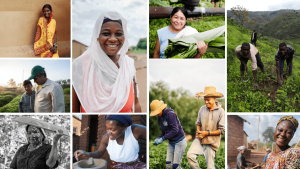COP 27: Are Carbon Markets A Solution To A More Sustainable World Or A New Speculative Bubble?
an EM Strategic Supporter Blog by Livelihoods
There are countless initiatives, ranging from start-ups which offer to plant trees, buy, or sell carbon credits, to a growing number of companies who seek to offset their carbon emissions, and many investors who promise ambitious financial returns. Attracted by the prospect or hope of a strong growth in carbon prices promised by many experts, financial investors are now interested in activities that they had previously neglected because they were considered not very profitable and too risky. Views by Bernard Giraud, President of Livelihoods Venture

9 November 2022 | In this maelstrom, there is a growing interest in “nature-based solutions” as they are called: the fight against deforestation, restoration of natural ecosystems, low-carbon agriculture, oceans, etc. We can be happy to see new players arrive and to see this sector finally taking off and mobilizing private capital to complement public investments. The stakes and needs are such on a global scale that this movement must be strongly supported and encouraged. However, to ensure that this craze for carbon finance contributes to truly sustainable solutions and does not end dramatically with the bursting of a speculative bubble, a certain number of rules must be established and respected. In the approach of COP 27, Bernard Giraud shares some thoughts inspired by his experience with the Livelihoods Funds.
Reducing versus compensating for carbon emissions? That is not the debate
The first of these rules is that carbon offsetting should not be a substitute for reduction efforts. The priority for each actor, whether private or public, is to engage in a profound transformation towards low-carbon practices. However, no actor can reach the “net zero” objective through reduction alone. Offsetting has therefore an important role to play and it makes no sense to oppose reducing and offsetting. But let’s not fight the wrong battle. The Livelihoods Funds have been investing in large-scale programs since 2009 and deliver significant volumes of certified carbon credits each year to companies that have invested in our funds to offset their unavoidable carbon emissions. Most importantly, the investments made have very significant social and environmental impacts for the local populations. What have we learned over the past decade?
Not all carbon projects are equal
First, not all “carbon projects” are equal. For example, investing in tree planting of a single species over hundreds of hectares certainly allows for the creation of a “carbon sink” and therefore for the acquisition of certified carbon credits. But does such a plantation have the same impact on biodiversity or the living conditions of local populations as an agroforestry project that helps hundreds of producers adopt sustainable agricultural practices? Is it enough to “plant trees” or, more broadly, to create the conditions for these trees to flourish? Does an industrial monoculture plantation have the same value as an investment in the preservation or restoration of a forest that is a living ecosystem rich in biodiversity? From a purely economic or carbon storage point of view, these projects can compete. Yet their impacts are very different. Looking at a project solely from the point of view of carbon yield or financial profitability can lead to dramatic errors. Because we are faced with the need to deeply transform our current production systems. This transformation must consider the diversity of environmental and social issues.
The projects supported by the Livelihoods funds succeed because they are based on the aspirations of the local rural communities. They contribute to environmentally sustainable solutions but also to improving the living conditions of farmers and their families. These systemic transformation projects are obviously more complex to design and implement. They require quite a specific know-how, a long preparation with competent teams and high-quality partners. They require time and finding the means to accompany this transformation over time. They require the courage to invest and take certain risks to provide the financial resources that poor rural communities often lack.
A systemic transformation of farming models
A major challenge for carbon finance is how it can contribute to the transformation of agriculture to meet both food and environmental needs. In the North, how can we support modern farms in their transformation to low-carbon agriculture, which restores soil fertility and biodiversity while maintaining a good level of production per hectare? In the South, how to support the hundreds of millions of smallholder family farms to ensure a decent income through agricultural practices that do not lead to the destruction of the still available natural resources?
The Livelihoods Funds work with companies that process agricultural raw materials for food or other products. These companies have recognized the need to support these transformations upstream of their industrial and commercial activities. More and more of them are setting targets for tonnages and hectares converted to regenerative agriculture practices. This necessary shift is complex and fraught with challenges. No single category of actor can make this shift successfully, on their own. We need operational coalitions that allow actors in the food chain to work together on concrete projects in each territory: farmers and their organizations, companies, NGOs, research, public authorities, etc. It is by combining the financial resources and skills of all these actors together that the transition becomes accessible to everyone.
A role assigned to the Governments: defining clear rules and finding the right balance
Since the Paris Agreements, several countries have made commitments to reduce their carbon footprint and most of them are in the process of defining the rules that will apply in their own country for the allocation and transfer of carbon rights under Article 6. The crucial question of solidarity and justice between formerly or recently developed countries with high emissions and developing countries with low emissions and high exposure to the effects of climate change has been at the heart of international negotiations for too many years.
The private funding provided through “voluntary carbon” projects can only be a contribution in addition to state agreements of a completely different scale. But this contribution can be significant for many states by focusing on nature-based solutions projects that are difficult to finance. The efforts of states and private investors in “carbon finance” should not be pitted against each other in sterile debates about “double accounting”. The carbon impacts generated by these projects benefit the territories and populations as much as the investors who took the risk of financing them. It is not a question of opposing approaches but rather of seeking synergies: it is in the interest of governments to attract financing that will enable them to move towards their climate objectives, and investors need a defined framework and clear rules to secure their rights.
Separate the wheat from the chaff
But which type of investments? If we look at the mainly financial motivations of some “carbon finance” players and their desire to simplify and focus solely on obtaining carbon credits, we can fear that the cure is sometimes worse than the disease. With the risk of discrediting carbon projects altogether. Therefore, we believe it is essential to encourage a segmentation of this market so that buyers of carbon credits can identify the real value of what they are buying. The Livelihoods Funds therefore support the efforts of standards and all stakeholders who are committed to carbon projects with high environmental and social value. It remains to succeed in this effort of differentiation without falling into the trap of multiplying complex standards and heavy bureaucratic processes that would weigh down projects, mobilize the energy of actors on the ground and increase costs to the detriment of action.
We are convinced that carbon finance can be a factor for progress if it supports projects that are truly transformative. It can help mobilize financial, technical, and human resources for large-scale projects over long periods. Let’s make sure that the “good wheat” does not get mixed up with the “bad wheat”.
Please see our Reprint Guidelines for details on republishing our articles.


